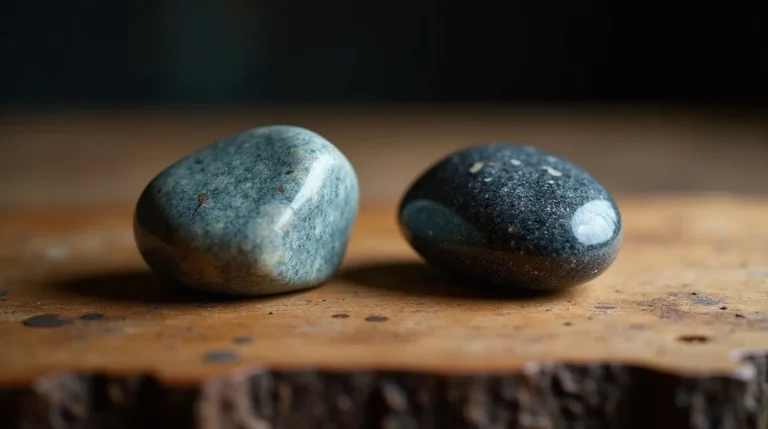Few days ago I write about Shale vs Slate, After reseatching more I also decided to compare Dacite vs Tracite, which are two unique volcanic rocks. They have different chemical compositions and mineral features. Knowing the differences between them can give you a deeper understanding of igneous geology.
This article will explore what makes dacite and tracite special. We’ll look at how they form, where they can be found, and their uses. By the end, you’ll appreciate the role of silica, alkali metals, and more in shaping these rocks.
Get ready to learn more about igneous petrology and volcanic rock classification. We’ll discover the unique traits of dacite and tracite. These two rocks are fascinating members of the igneous family.
Introduction to Volcanic Rocks
Volcanic rocks are fascinating and varied. They form when lava cools quickly at the Earth’s surface. These rocks give us a glimpse into how our planet changes.
To understand volcanic rocks, we need to know about extrusive and intrusive rocks. We also need to look at their silica content and alkali metal makeup.
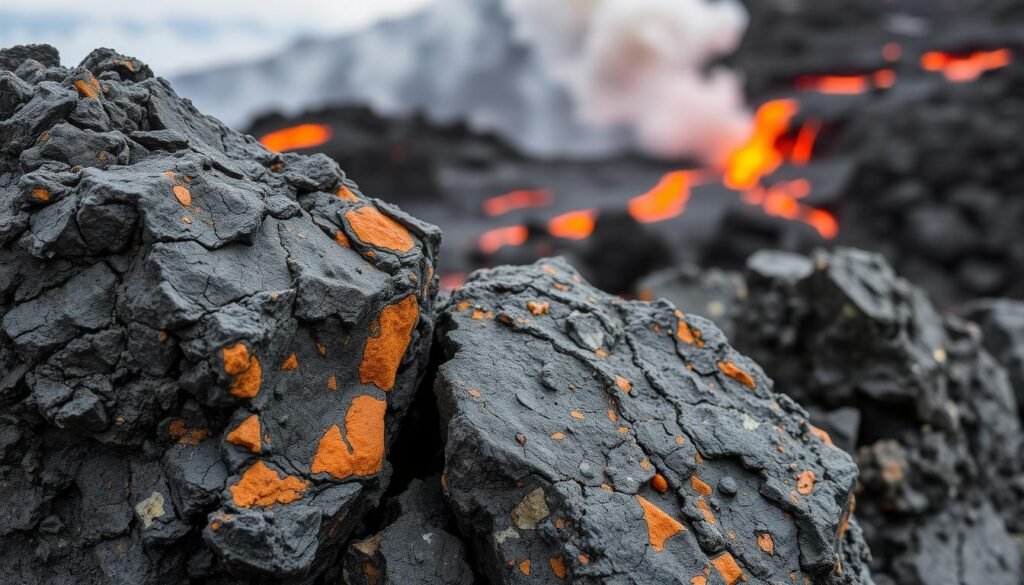
Extrusive and Intrusive Igneous Rocks
Volcanic rocks cool and solidify on the Earth’s surface. This makes them extrusive igneous rocks. On the other hand, intrusive rocks cool and solidify underground.
This difference in cooling affects their texture and minerals. It makes each rock type unique.
Significance of Silica Content and Alkali Metals
The silica and alkali metal content in volcanic rocks is key. It affects their minerals and physical traits. For example, rocks with more silica and alkali are lighter and have thicker lava flows.
Knowing about these factors helps us understand how volcanic rocks form and behave.
| Rock Type | Silica Content (%) | Alkali Oxide Content (%) |
|---|---|---|
| Trachyte | 60-65 | Over 7 |
| Trachydacite | Over 20% normative quartz | Varies |

What is Dacite?
Dacite is a fascinating volcanic rock that interests both geologists and rock fans. It has a silica content of 63-69% and an alkali content of less than 7%. This makes dacite stand out from other igneous rocks.
Chemical Composition of Dacite
Dacite is made up mainly of plagioclase feldspar, with some quartz, biotite, and hornblende. This mix of minerals gives dacite a special chemical makeup. The balance between silica and alkali content affects its physical and visual properties.
Mineralogy and Texture of Dacite
Dacite can have two textures: porphyritic and aphanitic. Porphyritic dacite has big crystals in a fine-grained base. Aphanitic dacite has tiny grains that can’t be seen without a magnifying glass. These textures show how the rock cooled and formed.
| Mineral | Percentage |
|---|---|
| Plagioclase Feldspar | 60-70% |
| Quartz | 10-20% |
| Biotite | 5-10% |
| Hornblende | 5-10% |
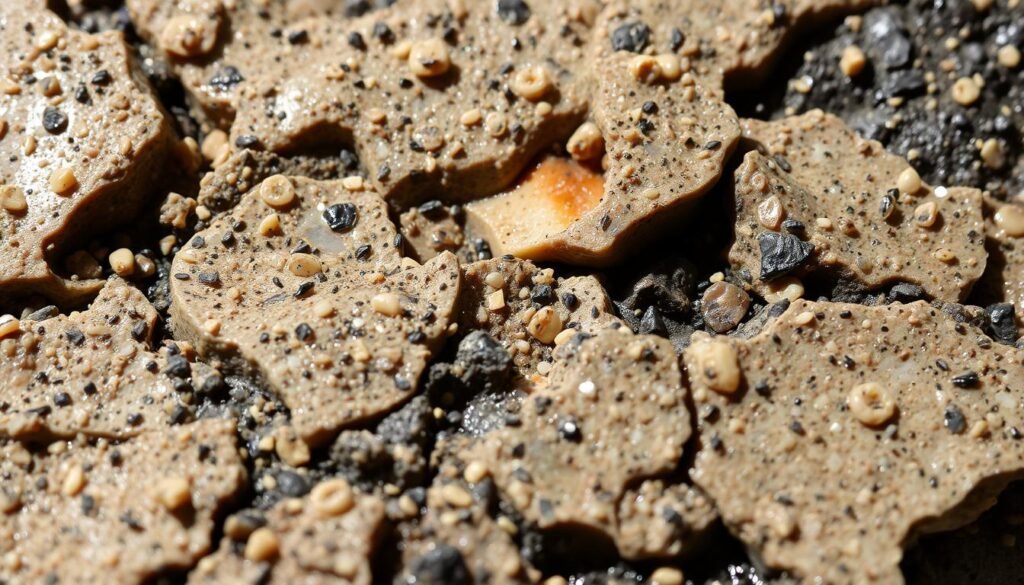
What is Tracite?
Tracite, also known as trachyte, is a volcanic rock that fascinates many. It has a silica content of 60-65% and an alkali oxide content over 7%. Its mineral makeup is mostly alkali feldspar, with some plagioclase feldspar, quartz, and minerals like biotite and clinopyroxene.
Tracite’s Silica and Alkali Oxide Content
Tracite stands out because of its high silica and alkali oxide levels. This makes it look different from other volcanic rocks. The silica and alkali metals like sodium and potassium make it light-colored and often have a porphyritic texture.
Mineral Assemblage and Appearance of Tracite
- Tracite is mostly alkali feldspar, with some plagioclase feldspar, quartz, and minerals like biotite and clinopyroxene.
- It has a porphyritic texture, with big feldspar crystals in a fine-grained base.
- This texture and mineral mix make tracite look unique and attractive, making it great for decoration and building.

Tracite’s special properties, like its silica and alkali content, make it interesting and useful. Its unique look and texture make it perfect for many uses, both practical and decorative.
Dacite vs Tracite: Key Differences
Dacite and tracite differ mainly in their chemical makeup and minerals. Dacite has more silica and less alkali than tracite. This affects the minerals found in each rock.
Variations in Silica and Alkali Content
Dacite has 63-69% silica, while tracite has 60-65%. But tracite has more sodium and potassium, over 7% in total. These differences help tell dacite and tracite apart.
Distinguishing Mineralogical Features
- Dacite has lots of plagioclase feldspar and quartz, with biotite and hornblende too.
- Tracite, however, has more alkali feldspar and less quartz than dacite.
- The mix of minerals and the rock’s look can help tell dacite from tracite.
| Property | Dacite | Tracite |
|---|---|---|
| Silica Content (SiO2) | 63-69% | 60-65% |
| Alkali Content (Na2O + K2O) | Less than 7% | Exceeding 7% |
| Dominant Feldspar | Plagioclase | Alkali Feldspar |
| Quartz Content | Higher | Lower |
| Ferromagnesian Minerals | Biotite, Hornblende | Augite |
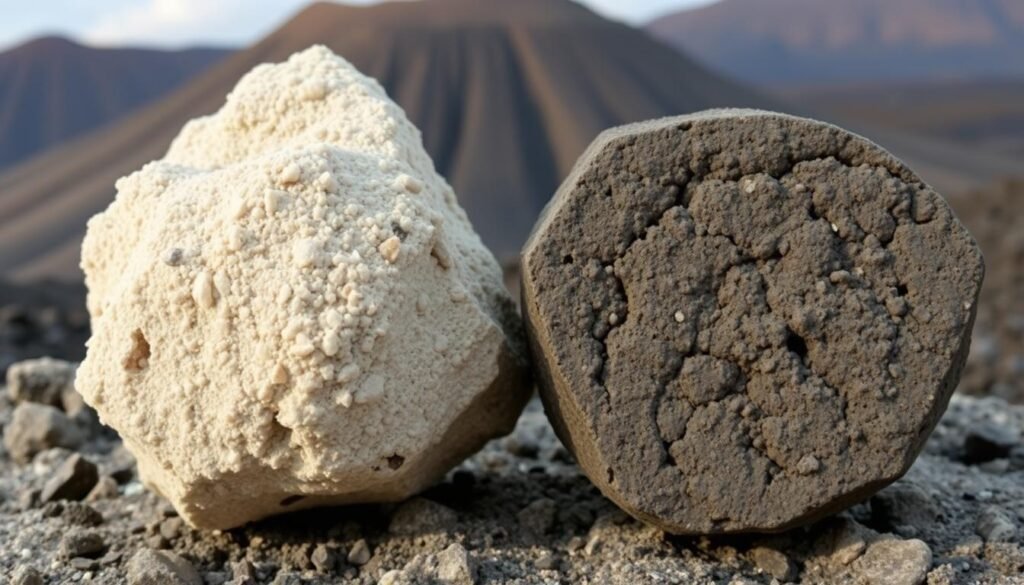
Formation and Geographic Distribution of Dacite
Dacite is a special igneous rock that forms when silica-rich magma cools and solidifies. This happens mainly in volcanic areas. The dacite formation is linked to volcanic processes and igneous activity.
Dacite is often found where tectonic plates meet, like at convergent plate boundaries. These areas have the right conditions for creating silica-rich magmas.
The geographic distribution of dacite shows its connection to volcanic settings. You can find dacite flows and domes in the Cascade Range, the Andes, and around the Pacific. These places have lots of volcanic activity and subduction zones.
| Prominent Dacite Locations | Tectonic Setting |
|---|---|
| Cascade Range (Western United States) | Convergent Plate Boundary |
| Andes Mountains (South America) | Convergent Plate Boundary |
| Pacific Ocean Volcanic Regions | Convergent Plate Boundary |
The formation and geographic distribution of dacite show how tectonic processes, magma, and eruptions shape our planet. Knowing how dacite forms and where it’s found helps us understand Earth’s geological history.
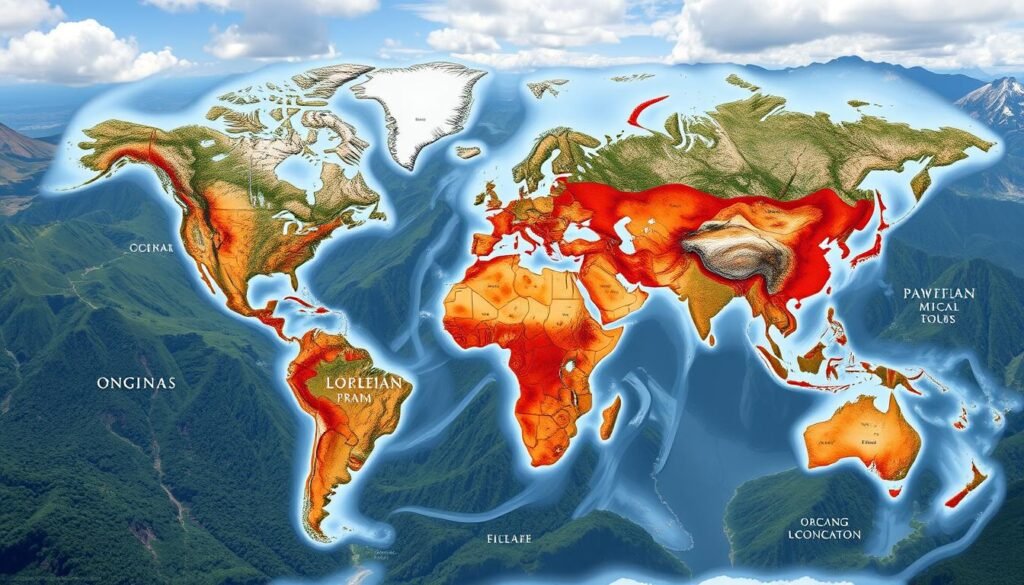
Formation and Geographic Distribution of Tracite
Tracite, also known as trachyte, is a volcanic rock formed from magma. This magma is rich in alkali and crystallizes fractionally. It often appears in areas with continental rift valleys and mantle plumes.
Trachyte in Continental Rift Valleys and Mantle Plumes
Trachyte is common in continental rift valleys, like the East African Rift System. The Earth’s crust stretches here, allowing alkali-rich magmas to rise. This leads to trachyte volcanoes and lava flows.
Trachyte is also found near mantle plumes. The hot magma from these plumes helps create trachytic rocks. For example, the Hawaiian Islands have trachyte alongside basaltic and hawaiitic lavas.
Trachyte in Areas of Back-Arc Extension
Trachyte also occurs in back-arc extension areas. These are zones where oceanic crust subducts, causing extension. The Aegean Sea and the Aeolian Arc in Italy are examples.
In these settings, trachyte forms from the melting of the mantle. The resulting magmas then fractionate, leading to trachyte formation.
Trachyte is found worldwide, including the Rhine district, Eifel, Britain, Italy, Iceland, and more. Its light color, fine-grained texture, and porphyritic appearance are distinctive. It’s a key feature in volcanic landscapes.

Applications of Dacite and Tracite
Decorative Building Stone and Dimension Stone
Dacite and tracite are two volcanic rocks loved for their beauty in building and design. Their unique texture and colors make them stand out. They were especially favored in ancient Roman and Venetian buildings.
Tracite was a favorite in the Roman Empire and Venice. It’s strong and looks great, making it perfect for buildings and decorations. The tracite applications in these places show its lasting beauty and versatility.
Dacite is also widely used in buildings around the world. Its texture and colors, from gray to reddish-brown, make it a favorite. It’s used for both looks and function in construction.
| Volcanic Rock | Silica Content | Alkali Oxide Content | Typical Applications |
|---|---|---|---|
| Dacite | 63-69% | 5-7% | Building stone, dimension stone, decorative architectural elements |
| Tracite | 60-65% | Over 7% | Dimension stone, decorative wall cladding, ornamental features |
Dacite and tracite remain popular in building and design. Their beauty and versatility make them a favorite choice.

Igneous Petrology and Volcanic Rock Classification
Igneous petrology is key to understanding volcanic rocks like dacite and tracite. It studies how these rocks form, what they’re made of, and how to classify them. The International Union of Geological Sciences (IUGS) has created detailed systems to sort volcanic rocks by their chemical and mineral makeup.
Two main tools in igneous petrology are the TAS and QAPF diagrams. These diagrams help geologists tell different volcanic rocks apart. They look at the rocks’ silica and alkali levels, and their minerals. This way, they can spot dacite and tracite among other rocks.
| Classification Scheme | Key Parameters | Volcanic Rock Types |
|---|---|---|
| TAS Diagram | Total alkali (Na2O + K2O) vs. Silica (SiO2) content | Basalt, Andesite, Dacite, Rhyolite |
| QAPF Diagram | Quartz, Alkali Feldspar, Plagioclase Feldspar, and Feldspathoid mineral content | Granite, Syenite, Diorite, Gabbro |
By using these classification systems, along with field work and lab tests, geologists can pinpoint different igneous rocks. This includes identifying dacite and tracite by their special chemical and mineral traits.

Identification and Analysis of Dacite and Tracite
To tell dacite and tracite apart, geologists use field observations and lab tests. They look at the rocks’ physical traits and do detailed analyses. This helps them know which rock is which.
Field Observations
At first, geologists can spot dacite and tracite by their looks. Dacite is light-gray to pale-pink and has big crystals in a finer mix. Tracite is light-gray to pale-yellow and has a smooth, fine texture without big crystals.
Laboratory Analysis
Lab tests are key to confirm dacite and tracite. A polarizing microscope lets geologists see the rocks’ minerals and texture up close. Tests like XRD and ICP-MS also check the rocks’ chemical makeup.
| Technique | Identification of Dacite | Identification of Tracite |
|---|---|---|
| Field Observations | Light-gray to pale-pink color, porphyritic texture with visible plagioclase and quartz crystals | Light-gray to pale-yellow color, fine-grained, uniform texture |
| Petrographic Analysis | Mineral assemblage of plagioclase, quartz, and biotite/hornblende | Mineral assemblage of alkali feldspar, with minor plagioclase and quartz |
| Geochemical Testing | Silica (SiO2) content typically between 63-69%, moderate alkali (Na2O + K2O) content | Silica (SiO2) content typically between 60-66%, higher alkali (Na2O + K2O) content |
Geologists use field observations and lab tests to tell dacite and tracite apart. These rocks have unique features that scientists study to understand their origins and properties.
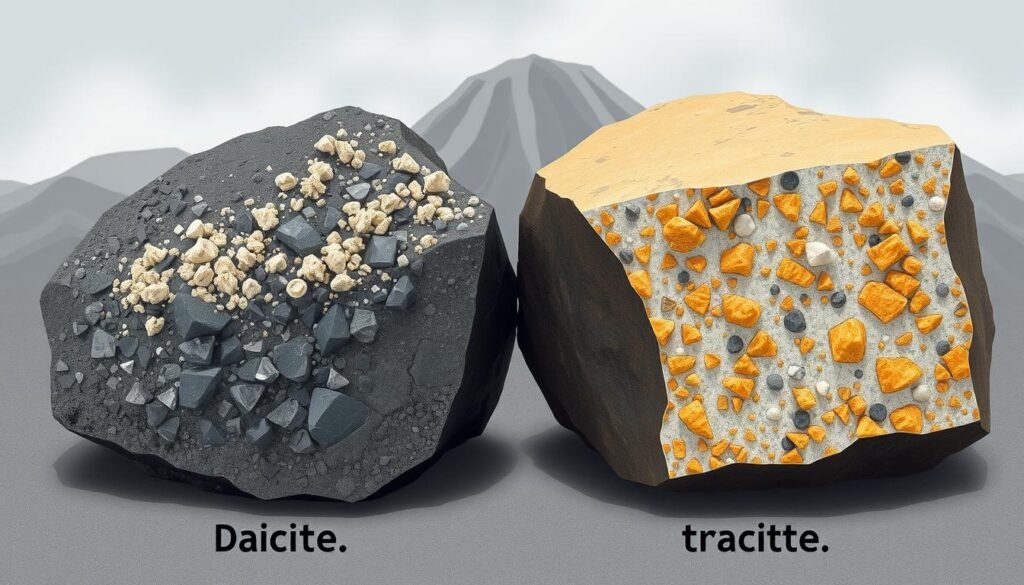
Environmental and Geological Significance
Dacite and tracite are key in the Earth’s geological and environmental processes. They help cycle elements in the Earth’s crust, water, and air. Their formation and weathering also give clues about a region’s past and its landscape.
These rocks are important for soil health and plant growth. As they break down, they release minerals that make soil fertile. This supports a wide range of plants and keeps ecosystems healthy. They also affect water quality and groundwater availability.
Geologically, dacite and tracite tell us about volcanic and tectonic activities. Their silica and alkali content reveal how they formed. By studying them, scientists learn about the Earth’s history, including volcanic and weathering events.
| Feature | Dacite | Tracite |
|---|---|---|
| Silica Content | 63-68% | 60-65% |
| Alkali Oxide Content | 4-6% | Exceeding 7% |
| Common Tectonic Settings | Subduction zones, continental arcs | Late stages of ocean island volcanism, continental rift valleys, above mantle plumes, areas of back-arc extension |
Understanding dacite and tracite helps us see how our planet works. This knowledge guides us in managing land and resources. It supports sustainable development and community growth.
Conclusion
Dacite and tracite are two unique volcanic rocks. They differ in their chemical makeup, minerals, and where they are found. Knowing the differences between dacite and tracite helps us appreciate the variety of rocks and how the Earth changes.
Studying dacite and tracite is key in igneous petrology. It helps us understand the Earth’s history and how rocks form. Whether you’re into geology, studying, or just curious, learning about dacite and tracite opens up new insights into volcanic rocks.
When comparing dacite and tracite, remember the importance of their chemical makeup, minerals, and where they are found. This knowledge not only deepens our understanding of rocks but also helps in identifying and studying them in the field or lab.







